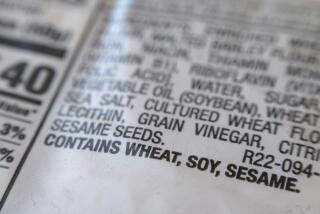Our Daily Spread : What’s ‘Lite’ Got to Do With It?
- Share via
The Peanut Advisory Board is persnickety about peanut butter, and its members don’t want anyone fooling around with a good thing. When Peter Pan introduced Smart Choice peanut butter in January with 25% less fat than regular, the Atlanta-based group immediately filed a complaint with the Food and Drug Administration.
What’s wrong with low-fat peanut butter? While the new product has the same number of calories as other peanut butters (95 calories per tablespoon), and the same amount of protein, vitamins and nutrients, it has only 12 grams of fat instead of 16. Peter Pan achieved the fat reduction by replacing peanuts with soy protein and sugar. According to FDA standards, peanut butter must contain 90% peanuts.
“We are not objecting to the fact that they are selling it,” says Mitch Head, executive director of the Peanut Advisory Board, which represents Southeastern peanut farmers. “The problem is the labeling. Nowhere on the jar does it say it contains 25% less peanuts.” The peanut farmers insist it should be called “peanut spread,” with the exact peanut percentage listed on the label.
The FDA normally requires a name change for products that don’t conform to its standards. For instance, jam with less than 65% sugar must be called “fruit spread.” “Low-fat” mayonnaise, made without eggs and oil, must be called “salad dressing.”
*
“We see it as an equivalent to a diet drink,” says Kay Carpenter, spokeswoman for Peter Pan. “You have Coke and Diet Coke. There’s peanut butter and reduced-fat peanut butter. And this is represented on the label and we think it’s very accurate.”
While the FDA is still looking into the matter, Skippy has just come out with a reduced-fat peanut butter too.
Peanut butter sales have recently slipped 9%. Manufacturers believe this is because consumers are concerned about the fat content of peanut butter.
One could reason that the Southeastern peanut farmers--who produce 80% of the peanuts that go into peanut butter--would welcome any new product that would help increase sales. Not so.
“Our concern isn’t whether we sell more,” says Head. “It’s just not right for someone to be tampering with a recipe that’s 100 years old. We care about the integrity of peanut butter.”
More to Read
Eat your way across L.A.
Get our weekly Tasting Notes newsletter for reviews, news and more.
You may occasionally receive promotional content from the Los Angeles Times.









